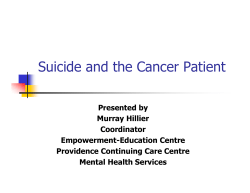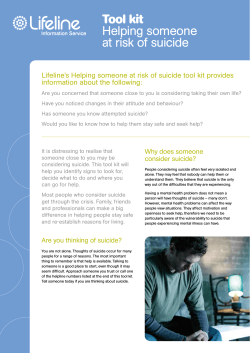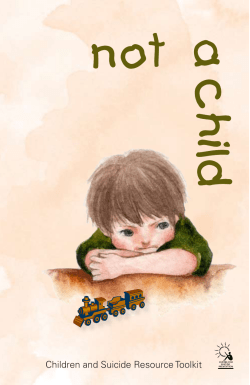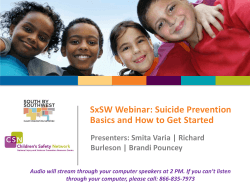
Suicide and Primary Care Contact in Cumbria Rachel E Brown
Suicide and Primary Care Contact in Cumbria Rachel E Brown October 2014 Acknowledgements The author would like to thank the following people: Ian Smith (Coroner South and East Cumbria), David Roberts (Coroner North and West Cumbria); Dr Rebecca Wagstaff, Colin Cox, Dr Jane Mathieson, Ian Twiselton, Fiona Johnson, and Paul Blaylock from Cumbria County Council; Dr Dave Dagnan, and Dr Phil Taylor from Cumbria Partnership Foundation Trust; Dr Andrew Rotheray and Linda Hendrey from NHS Cumbria Clinical Commissioning Group; and Chris Sheldon and Gail Watson from LaSCA. Thanks also to all members of the Cumbria Suicide Prevention Leadership Group and Dr Gordon Hay from the Centre of Public Health. Centre for Public Health Liverpool John Moores University Henry Cotton Building 15-21 Webster Street Liverpool L3 2ET Key Messages for Primary Care Most individuals who die by suicide in Cumbria consult with their GP in the year prior to death, and over one fifth consult in the week prior. A total of 7 (9%) individuals who died by suicide in Cumbria had not seen their GP in the previous year, and non-attenders were more likely to be male. As recommended by the NCISH, the current NHS Health Check in primary care should be amended to include mental health, as a step to identifying risk in non-attenders. To consider the impact of chronic pain and other long term conditions in connection with other known suicide risk and escalating factors when carrying out individual suicide risk assessments Psychotropic drug treatment in Cumbria is higher compared to nationally. The NCISH state that people who are prescribed such drugs should be seen as at risk, and that receiving multiple psychotropic drugs is associated with higher suicide risk and could be a marker of risk in primary care. 1 1. Introduction This is a supplementary report to the ‘Avoidable Mortality in Cumbria: A Case File Review of 78 Suicides’ document. The results presented below are based on suicides of Cumbria residents that were registered between 01 Jan 2012 to 31 Dec 2012 and 01 Apr 2013 to 18 Aug 2013. Further information regarding the definition of suicide and methodology used can be obtained from the main report and it is recommended that the two reports be read in conjunction with one another. 2. Suicides in Contact with Primary Care in England The National Confidential Inquiry into Suicide and Homicide by Mental Illness (NCISH) states that most people who die by suicide have seen their general practitioner (GP) in the previous 12 months before death. The NCISH notes that although this may provide an opportunity for prevention, identifying patients who are at particular risk is challenging.1 The NCISH report into suicides in contact with primary care between 2002 and 2011 found that overall 63% of individuals consult face-to-face with their GP in the 12 months before suicide.1 Where possible, the results for Cumbria which are presented below make comparison to the findings of the NCISH report, however the results for Cumbria are based on smaller numbers and therefore comparisons should be interpreted with caution. 3. Suicides in Contact with Primary Care in Cumbria Patient Characteristics Of the 78 suicides that were reviewed, 77% were male, and the average age at the time of death was 51 years (44 years for males and 69 years for females). The number of these patients who had seen their GP, had a mental health diagnosis, received drug treatment, or were also seen by specialist mental health services in the last year (patient suicide) is demonstrated in figure 1. Consultations with the GP The majority of individuals had face-to-face contact with their GP prior to suicide. Overall, 63 (81%) of individuals consulted with their GP in the year before suicide, this is a higher proportion compared to the 63% for England (figure 1). Further analysis revealed that 35 (45%) individuals had consulted with their GP in the preceding month, and 17 (22%) consulted in the preceding week. Females were more likely than males to have contact with their GP prior to suicide. The average number of days between an individual’s last contact with their GP and the date of death was 136 days; the median number of days was 30.5 days, ranging from 1 day to 1,867 days. 2 Consultation patterns varied by patient characteristics. Females were more likely than males to have consulted with their GP in the year before death; 94% and 77% respectively. Older patients were also more likely to consult with their GP in the year prior. Of the 63 individuals who had contact with their GP in the previous 12 months, 46% consulted due to mental health reasons, 40% consulted for physical health reasons, and 13% consulted for both mental and physical health reasons. Individuals aged 25-64 were more likely to be seen for mental health reasons, whilst those aged <25 and >65 were more likely to be seen for physical health reasons. For individuals who consulted with their GP in the 12 months before they died, the number of mental health related consultations ranged from 1 -19, and the mean number was 4 and median was 2.5. Females consulted with their GP for mental health reasons more frequently than males. The mean number of female mental health consultations was 7, compared to 2 for males. 78 individuals who died by suicide in Cumbria Face-to-face GP consultation within 12 months of suicide number = 63 (81%) (Eng = 63%) Clinical time line Mental health diagnosis (any time) number = 49 (63%) (Eng = 63%) Psychotropic drug treatment within 12 months of suicide number = 47 (60%) (Eng = 48%) Seen by specialist mental health services within 12 months of suicide (patient suicide) number = 28 (36%) Figure 1. Number and percentage (%) of suicides in Cumbria: GP consultation, mental health diagnosis, drug treatment and contact with specialist mental health services 3 Mental Health Diagnosis 49 (63%) of individuals who died by suicide had a diagnosis of a current/on-going mental health diagnosis, and this corresponds to the England proportion (figure 1). Of the 49 individuals who had a current/on-going mental health diagnosis, 33 (67%) had a diagnosis of depression. This is slightly lower than the England proportion of 71%. Of the 33 individuals who had a diagnosis of depression, 15 (45%) had a diagnosis of at least one other mental health condition, this was most commonly alcohol dependence/misuse (n=6) followed by anxiety (n=5). Of the 49 individuals who had a current/on-going mental health diagnosis, 13 (27%) had a diagnosis of alcohol and/or substance dependence/misuse. Of the 49 individuals who had a current/on-going mental health diagnosis, 12 (15%) had their mental health condition diagnosed in the 12 months before suicide. This is lower than the England proportion of 26%. Prescribed Drugs 47 (60%) individuals had been prescribed a psychotropic drug in the last 12 months before suicide; this was higher than the England proportion of 48% (figure 1). Prescriptions for selective serotonin reuptake inhibitors (SSRI) antidepressants were most common in the last 12 months (35%). SSRI prescriptions were also the most common nationally (table 1). Citalopram was the most commonly prescribed SSRI (n=12), followed by Fluoxetine (n=8), and Sertraline (n=6). Of the 47 individuals who had been prescribed a psychotropic drug in the last 12 months, 25 (53%) individuals had been prescribed drugs from two of more drug groups. History of Self-Harm Of the 78 suicides reviewed, 33 (42%) individuals were known to have a history of self-harm, most commonly prior to 12 months before death. Females were more likely than males to have a history of self-harm (56% and 38% respectively). 4 Physical Health Conditions Of the 78 suicides reviewed, 45 (58%) individuals had at least one physical health condition diagnosis. Of the 78 suicides reviewed, 18 (23%) individuals had a pain related diagnosis (such as back pain, arthritis, neurologic pain, sciatica, gout and fibromyalgia). In total 5 were related to back pain. Of the 78 suicides reviewed, 8 (10%) individuals had a disease of the digestive system (such as chrons disease, coeliac disease and benign polyps). Of the 78 suicides reviewed, 5 (6%) individuals had diagnosis of diabetes, most commonly type II diabetes. Table 1. Percentage (%) of psychotropic drug prescriptions in the last 12 months in Cumbria, compared to England Psychotropic drug group Cumbria % England % Typical antipsychotics 0 6 Atypical antipsychotics 8 9 Depot antipsychotics 1 0.5 Lithium and other mood stabilisers 3 4 SSRI antidepressants 35 25 Tricyclic antidepressants 10 12 Other anti-depressants 15 12 Benzodiazepines 5 19 Other anxiolytics and hypnotics 22 14 Opioid analgesics 6 11 4. Key Messages for Primary Care Most individuals in Cumbria consult with their GP in the 12 months prior to suicide, with over a fifth (22%) consulting in the week before death. A total of 7 (9%) individuals who died by suicide in Cumbria had not seen their GP in the previous year, and non-attenders were more likely to be male. The NCISH state that suicide prevention in people who do not attend in primary care is clearly difficult and that GPs cannot be expected to assess people who currently do not attend. For younger age groups, dedicated services such as in the voluntary sector or internet based supports may offer a more realistic approach to prevention. Given that the average age of males in Cumbria who died by suicide was 44 years, the current NHS Health Check could offer a way of identifying suicide risk in people aged 40 (particularly non-attenders) and the NCHISH believe that the NHS Health Check should be amended to include mental health. They state that simple screening for depression is 5 unproven but targeting case-finding in men with other risk factors may be a more clinically appropriate approach. A diagnosis of a pain related health condition was present for 18 (23%) individuals, the most common of which was back pain. Diseases of the digestive system and diabetes were also revealed as conditions that were among the top three prevalence types of condition at the time of death. The issue of chronic pain as a key risk factor for suicide in Cumbria was also revealed from research carried out in 2008.2 Based on the current and previous findings, it is suggested that health care professionals consider the impact of chronic pain and other long term conditions in connection with other known suicide risk and escalating factors when carrying out individual suicide risk assessments. Overall, the prescription of psychotropic drugs in Cumbria is higher compared to nationally, although the prescription of some psychotropic drug groups is lower compared to nationally. The NCISH found that people who are prescribed these drugs should be seen as at risk, and that receiving multiple psychotropic drugs is associated with higher suicide risk and could be a marker of risk in primary care. In Cumbria, over half (53%) of those with a psychotropic drug prescription in the 12 months before death, were prescribed drugs from more than one drug type. 5. References 1. Appleby L, Kapur N, Shaw J, Hunt IM, While D, Flynn S et al. The National Confidential Inquiry into Suicide and Homicide by People with Mental Illness: Annual Report. July 2013 (http://www.bbmh.manchester.ac.uk/centreforsuicideprevention/nci/reports/AnnualReport20 13_UK.pdf) 2. Siddle R, Mathieson J, Brown R. Risk factors and escalators in 52 suspected suicides. The Cumbria Partnership Journal of Research, Practice and Learning 2011. 1 (2): 9-13 Centre for Public Health Faculty of Education, Health and Community Liverpool John Moores University 2nd Floor, Henry Cotton Campus 15-21 Webster Street Liverpool L3 2ET Email: r.e.brown@ljmu.ac.uk 6
© Copyright 2025













